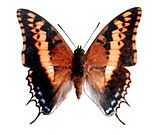Charaxes jasius
| Charaxes jasius | |
|---|---|
| | |
| Dorsal view | |
| | |
| Ventral view | |
| Scientific classification | |
| Kingdom: | Animalia |
| Phylum: | Arthropoda |
| Class: | Insecta |
| Order: | Lepidoptera |
| Family: | Nymphalidae |
| Genus: | Charaxes |
| Species: | C. jasius |
| Binomial name | |
| Charaxes jasius (Linnaeus, 1767) | |
| Synonyms | |
| |
Charaxes jasius, the Two-tailed Pasha or Foxy Emperor, is a butterfly in the family Nymphalidae. It is the only European species of the genus Charaxes.
Description
Charaxes jasius is a medium to large butterfly with a wingspan reaching 65–75 mm in males and 75–90 mm in females.[1] The uppersides of the wings are dark brown with orange margins. The hind wings bring two short tails, characteristic of most species of the genus. Close to these tails there are a few blue markings. The underside of the wings is reddish brown with numerous darker bands edged with white or gray. The orange marginal band is also present on the undersides of the wings and it is preceded by a white transversal band. The caterpillar is green, cylindrical and has two yellow ocelli on the back. The head bears four horns facing backwards.
Food plants
The adults prefer ripe fruits, of which they suck the sugary liquids. The larvae feed on a wide range of plants, including Afzelia quanzensis, Annona (including Annona cherimola), Arbutus unedo, Bauhinia (including Bauhinia galpinii and Bauhinia petersiana), Berlinia, Brachystegia (including Brachystegia edulis and Brachystegia spiciformis), Burkea africana, Cassia, Cassine, Catha edulis, Celtis africana, Colophospermum mopane, Copaifera baumiana, Croton, Daniella oliveri, Guibourtia conjugata, Gymnosporia (including Gymnosporia senegalensis), Hibiscus, Isoberlina, Julbernardia globiflora, Khaya senegalensis, Laurus nobilis, Lonchocarpus cyanescens, Lonchocarpus sericeus, Maytenus, Osyris lanceolata, Pleurostylia africana, Protea, Prunus persica, Pseudocedrala, Schotia brachypetala, Sorghum (including Sorghum roxburghii), Vaccinium corymbosum, Xanthocercis zambesiaca and Xeroderris stuhlmannii.[2]
Life cycle
Charaxes jasius has two generations per year: the first in May–June and the second in August–September. After the second it spends the winter in the larval stage, to flicker the next spring. The female lays the eggs on the upper surface of the leaves of the host plant, laying no more than one egg per leaf. The larva make a kind of "bed" by silky wires, on which it returns promptly after feeding on surrounding leaves. Then they hang on a twig and pupate. After a period that can range from two weeks to one month, the pupa opens letting out the butterfly.
Distribution
This species occurs in the Mediterranean region and Africa.[2] In Africa, it has been recorded from North Africa, Senegal, Gambia, Guinea-Bissau, Guinea, Mali, Sierra Leone, Liberia, Ivory Coast, Burkina Faso, Ghana, Togo, Benin, Nigeria, Niger, Cameroon, Gabon, the Republic of Congo, Angola, the Central African Republic, the Democratic Republic of Congo, Sudan, Uganda, Ethiopia, Somalia, Kenya, Tanzania, Malawi, Zambia, Mozambique, Zimbabwe, Botswana, Namibia, South Africa and Swaziland.[3]
Habitat
Its typical habitat in Europe is the Maquis shrubland, up to 700–800 meters above sea level. In Africa it is found in savanna and thornbelt habitats.
Subspecies
- C. j. jasius (Southern Europe, North Africa)
- C. j. brunnescens Poulton, 1926 (Gabon, northern Angola, Central African Republic, south-western Democratic Republic of Congo)
- C. j. epijasius Reiche, 1850 (Senegal, Gambia, Guinea-Bissau, Guinea, Mali, Sierra Leone, Liberia, Ivory Coast, Burkina Faso, Ghana, Togo, Benin, Nigeria, Niger, Cameroon, Central African Republic, Democratic Republic of Congo, southern Sudan, northern Uganda, northern Ethiopia, Somalia, north-western Kenya) - Cream-bordered Charaxes
- C. j. harrisoni Sharpe, 1904 (south-western Uganda, south-western Kenya, north-western Tanzania)
- C. j. pagenstecheri Poulton, 1926 (southern Ethiopia, Somalia)
- C. j. saturnus Butler, 1866 (eastern and north-eastern Kenya, Tanzania, Malawi, central and southern Democratic Republic of Congo, Angola, Zambia, Mozambique, Zimbabwe, Botswana, north-eastern Namibia, South Africa, Swaziland) - Foxy Charaxes or Koppie Charaxes
Taxonomy
The members of the Charaxes jasius group are:
- Charaxes jasius
- Charaxes pelias – smaller than jasius
- Charaxes hansali
- Charaxes castor
- Charaxes brutus – dark with white bands
- Charaxes andara – Madagascar
- Charaxes ansorgei
- Charaxes phoebus
- Charaxes pollux
- Charaxes druceanus
- Charaxes phraortes – Madagascar, close to next
- Charaxes andranodorus – close to last
- Charaxes eudoxus
- Charaxes richelmanni




References
| Wikimedia Commons has media related to Charaxes jasius. |
- Victor Gurney Logan Van Someren, 1963 Revisional notes on African Charaxes (Lepidoptera: Nymphalidae). Part I. Bulletin of the British Museum (Natural History) (Entomology) 195-242.
External links
- Charaxes saturnus images at Bold
- Charaxes jasius images at Consortium for the Barcode of Life
- Charaxes jasius brunnescens images at BOLD
- Charaxes epijasius images at BOLD
- Images of C. jasius brunnescens Royal Museum for Central Africa (Albertine Rift Project)
- Images of C. jasius epijasius (Albertine Rift Project)
- Images of C. jasius jasius (Albertine Rift Project)
- Images of jasius saturnus (Albertine Rift Project)